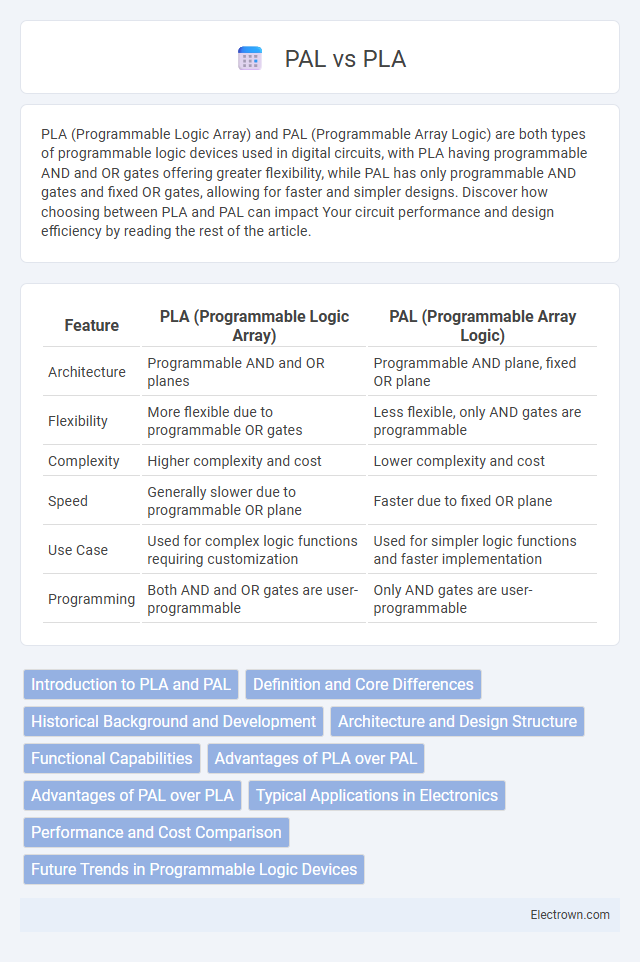PLA (Programmable Logic Array) and PAL (Programmable Array Logic) are both types of programmable logic devices used in digital circuits, with PLA having programmable AND and OR gates offering greater flexibility, while PAL has only programmable AND gates and fixed OR gates, allowing for faster and simpler designs. Discover how choosing between PLA and PAL can impact Your circuit performance and design efficiency by reading the rest of the article.
Table of Comparison
| Feature | PLA (Programmable Logic Array) | PAL (Programmable Array Logic) |
|---|---|---|
| Architecture | Programmable AND and OR planes | Programmable AND plane, fixed OR plane |
| Flexibility | More flexible due to programmable OR gates | Less flexible, only AND gates are programmable |
| Complexity | Higher complexity and cost | Lower complexity and cost |
| Speed | Generally slower due to programmable OR plane | Faster due to fixed OR plane |
| Use Case | Used for complex logic functions requiring customization | Used for simpler logic functions and faster implementation |
| Programming | Both AND and OR gates are user-programmable | Only AND gates are user-programmable |
Introduction to PLA and PAL
PLA (Programmable Logic Array) and PAL (Programmable Array Logic) are types of programmable logic devices used to implement combinational logic circuits. PLA offers flexibility with programmable AND and OR gates, allowing customized logic functions, while PAL provides faster performance with a fixed OR array and programmable AND gates. Understanding the differences between PLA and PAL helps you choose the right device for specific digital design applications.
Definition and Core Differences
PLA (Programmable Logic Array) is a digital logic device used for implementing combinational logic circuits by programming both its AND and OR gates, offering high flexibility. PAL (Programmable Array Logic) is similar but features a fixed OR array and a programmable AND array, simplifying design and improving speed at the cost of reduced flexibility. The core difference between PLA and PAL lies in programmability: PLA allows customization of both AND and OR planes, while PAL only permits programmability in the AND plane, resulting in distinct trade-offs in complexity and performance.
Historical Background and Development
PLA (Programmable Logic Array) was developed in the 1970s as a programmable device used to implement combinational logic circuits, providing greater flexibility compared to fixed logic gates. PAL (Programmable Array Logic) emerged shortly after as a simplified, cost-effective alternative featuring a fixed OR array and programmable AND array, which enhanced speed and ease of programming. Both technologies revolutionized digital circuit design by allowing engineers to customize logic functions without creating new hardware for each application.
Architecture and Design Structure
PLA (Programmable Logic Array) features a fixed AND plane followed by a programmable OR plane, allowing customizable logic functions with a simpler design structure suited for smaller, less complex logic circuits. PAL (Programmable Array Logic) uses a programmable AND plane and a fixed OR plane, offering faster operation speeds and easier scalability for complex logic applications due to its more flexible architecture. The structural difference where PLA's OR plane is programmable enables more versatility, whereas PAL's fixed OR plane yields quicker response times and lower production costs.
Functional Capabilities
PLA (Programmable Logic Array) and PAL (Programmable Array Logic) differ significantly in functional capabilities. PLA offers programmable AND and OR planes, allowing for more complex logic functions and greater customization, while PAL provides a fixed OR plane with only programmable AND gates, resulting in faster performance but less flexibility. Your choice depends on the complexity of the logic design and the need for adaptability versus speed.
Advantages of PLA over PAL
PLA (Programmable Logic Array) offers greater flexibility than PAL (Programmable Array Logic) because both the AND and OR planes in PLA are programmable, allowing for more complex logic implementations and customization. PLAs support a wider range of logic functions and are ideal for applications requiring intricate combinational logic with multiple product terms. This programmability advantage enables designers to optimize circuit density and functionality more efficiently compared to the fixed OR plane structure of PAL devices.
Advantages of PAL over PLA
PAL offers greater flexibility in implementing complex logic functions due to its programmable logic arrays, enabling customized connections between inputs and outputs. It typically provides faster processing speeds compared to PLA, as the fixed AND plane reduces propagation delay. PAL devices also tend to have simpler design architecture, resulting in lower manufacturing costs and improved reliability in digital circuit applications.
Typical Applications in Electronics
PLA (Programmable Logic Array) is commonly used in digital circuit design for implementing combinational logic functions, such as simple processors, decoders, and multiplexers. PAL (Programmable Array Logic) is preferred in applications requiring faster speed and easier programming, including address decoding and simple state machines in embedded systems. Understanding these differences helps you choose the appropriate device for specific electronic applications, optimizing performance and design flexibility.
Performance and Cost Comparison
PLA devices generally offer faster programming speeds and simpler design complexity compared to PALs, making them suitable for applications requiring rapid development and moderate logic density. PALs tend to have lower unit costs due to their standardized architecture and mass production, which benefits high-volume manufacturing where budget constraints are critical. Your choice between PLA and PAL should weigh the need for performance against the total cost of ownership, considering factors like design flexibility and scalability.
Future Trends in Programmable Logic Devices
Future trends in programmable logic devices highlight significant advancements in both PLA (Programmable Logic Array) and PAL (Programmable Array Logic) technologies, with a strong focus on increased integration, speed, and power efficiency. Emerging developments in PLA and PAL aim to support complex applications like AI and edge computing by incorporating higher density logic blocks and enhanced reprogrammability. Your designs can benefit from these innovations, providing scalable solutions that adapt to rapidly evolving digital systems.
PLA vs PAL Infographic

 electrown.com
electrown.com